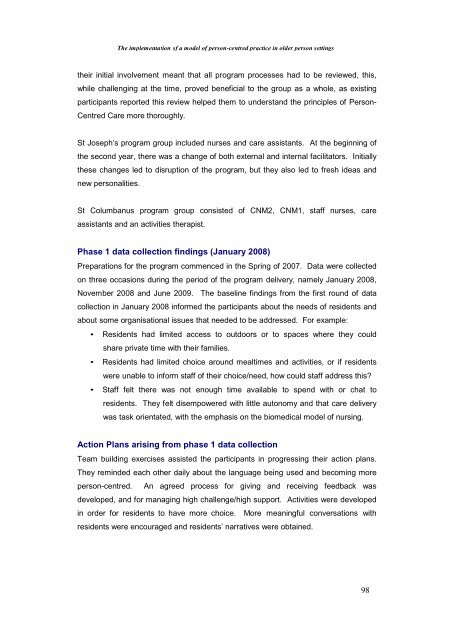The Implementation of a Model of Person-Centred Practice In Older ...
The Implementation of a Model of Person-Centred Practice In Older ...
The Implementation of a Model of Person-Centred Practice In Older ...
You also want an ePaper? Increase the reach of your titles
YUMPU automatically turns print PDFs into web optimized ePapers that Google loves.
<strong>The</strong> implementation <strong>of</strong> a model <strong>of</strong> person-centred practice in older person settings<br />
their initial involvement meant that all program processes had to be reviewed, this,<br />
while challenging at the time, proved beneficial to the group as a whole, as existing<br />
participants reported this review helped them to understand the principles <strong>of</strong> <strong>Person</strong>-<br />
<strong>Centred</strong> Care more thoroughly.<br />
St Joseph’s program group included nurses and care assistants. At the beginning <strong>of</strong><br />
the second year, there was a change <strong>of</strong> both external and internal facilitators. <strong>In</strong>itially<br />
these changes led to disruption <strong>of</strong> the program, but they also led to fresh ideas and<br />
new personalities.<br />
St Columbanus program group consisted <strong>of</strong> CNM2, CNM1, staff nurses, care<br />
assistants and an activities therapist.<br />
Phase 1 data collection findings (January 2008)<br />
Preparations for the program commenced in the Spring <strong>of</strong> 2007. Data were collected<br />
on three occasions during the period <strong>of</strong> the program delivery, namely January 2008,<br />
November 2008 and June 2009. <strong>The</strong> baseline findings from the first round <strong>of</strong> data<br />
collection in January 2008 informed the participants about the needs <strong>of</strong> residents and<br />
about some organisational issues that needed to be addressed. For example:<br />
• Residents had limited access to outdoors or to spaces where they could<br />
share private time with their families.<br />
• Residents had limited choice around mealtimes and activities, or if residents<br />
were unable to inform staff <strong>of</strong> their choice/need, how could staff address this?<br />
• Staff felt there was not enough time available to spend with or chat to<br />
residents. <strong>The</strong>y felt disempowered with little autonomy and that care delivery<br />
was task orientated, with the emphasis on the biomedical model <strong>of</strong> nursing.<br />
Action Plans arising from phase 1 data collection<br />
Team building exercises assisted the participants in progressing their action plans.<br />
<strong>The</strong>y reminded each other daily about the language being used and becoming more<br />
person-centred. An agreed process for giving and receiving feedback was<br />
developed, and for managing high challenge/high support. Activities were developed<br />
in order for residents to have more choice. More meaningful conversations with<br />
residents were encouraged and residents’ narratives were obtained.<br />
98
















